With the help of the Solar Heliospheric Observatory you can not only keep track of the planets in the daytime sky but maybe even discover a comet.
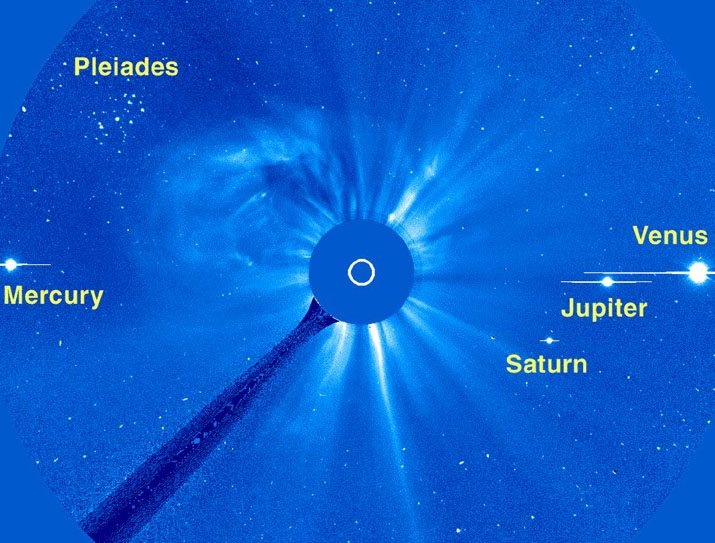
ESA / NASA / SOHO
Nature is replete with rhythms. Earth spins, planets revolve, variable stars pulsate, and the moon waxes and wanes. Many of us watched Jupiter and Saturn squeeze together during the recent Great Conjunction, then followed them until they disappeared in the solar glare in January.
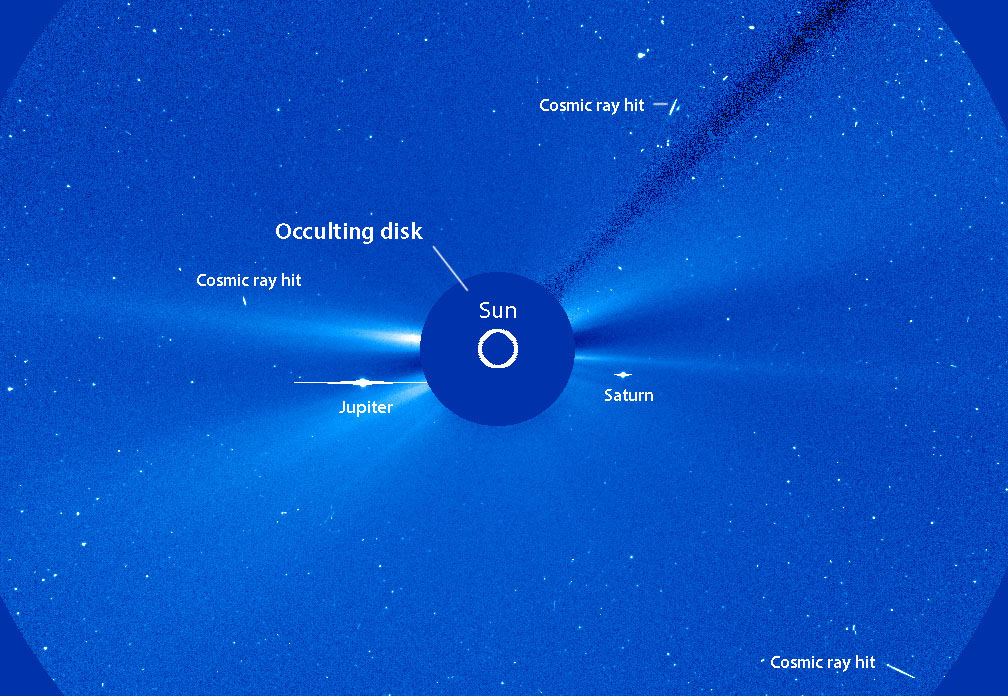
ESA / NASA / SOHO
Proximity to the Sun during solar conjunction temporarily interrupted our view of the planets. Broke the rhythm as it were. Saturn and Jupiter won't return to visibility until the end of February at dawn. But why wait? I got on the web, dialed up the Solar and Heliospheric Observatory (SOHO) site, and watched each planet sidle up to the Sun during their transition from the evening to morning sky.
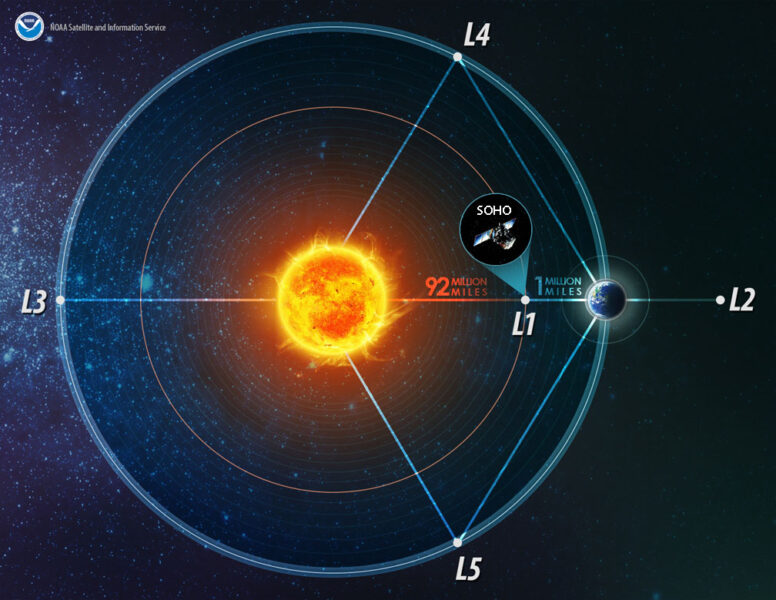
NOAA with SOHO inset by ESA
Launched in December 1995, SOHO is a joint venture between NASA and the European Space Agency (ESA). It orbits near the first Lagrangian Point (L1), a region where the gravitational tugs of the Sun and Earth are at equilibrium, providing a 'parking place' for the spacecraft. L1 is located 1.5 million kilometers inside Earth's orbit, an ideal spot for SOHO to keep a continuous watch on our tempestuous star.
Among its suite of instruments is the Large Angle and Spectrometric Coronagraph Experiment (LASCO) that comprises three telescopes dubbed C1, C2, and C3, each of which employs an opaque occulting disk to block the Sun from view. On Earth, the atmosphere scatters sunlight and makes the sky blue, but in airless space, the coronagraphs capture crisp views of the solar corona as well as coronal mass ejections — powerful eruptions of plasma that occur in the wake of solar flares and prominence ejections. They also record everything else crossing the field of view including stars, planets, asteroids, comets, and even a few deep-sky objects.
LASCO C1 went belly-up in 1998 after a bad command caused a loss of communication and other issues, but C2 and C3 came through unscathed. LASCO C3 has a field of view about 16° across, equal to 45 million kilometers at the distance of the Sun, or half the diameter of Mercury's orbit. The C2 coronagraph focuses in more narrowly; its field of view encompasses about 3°.
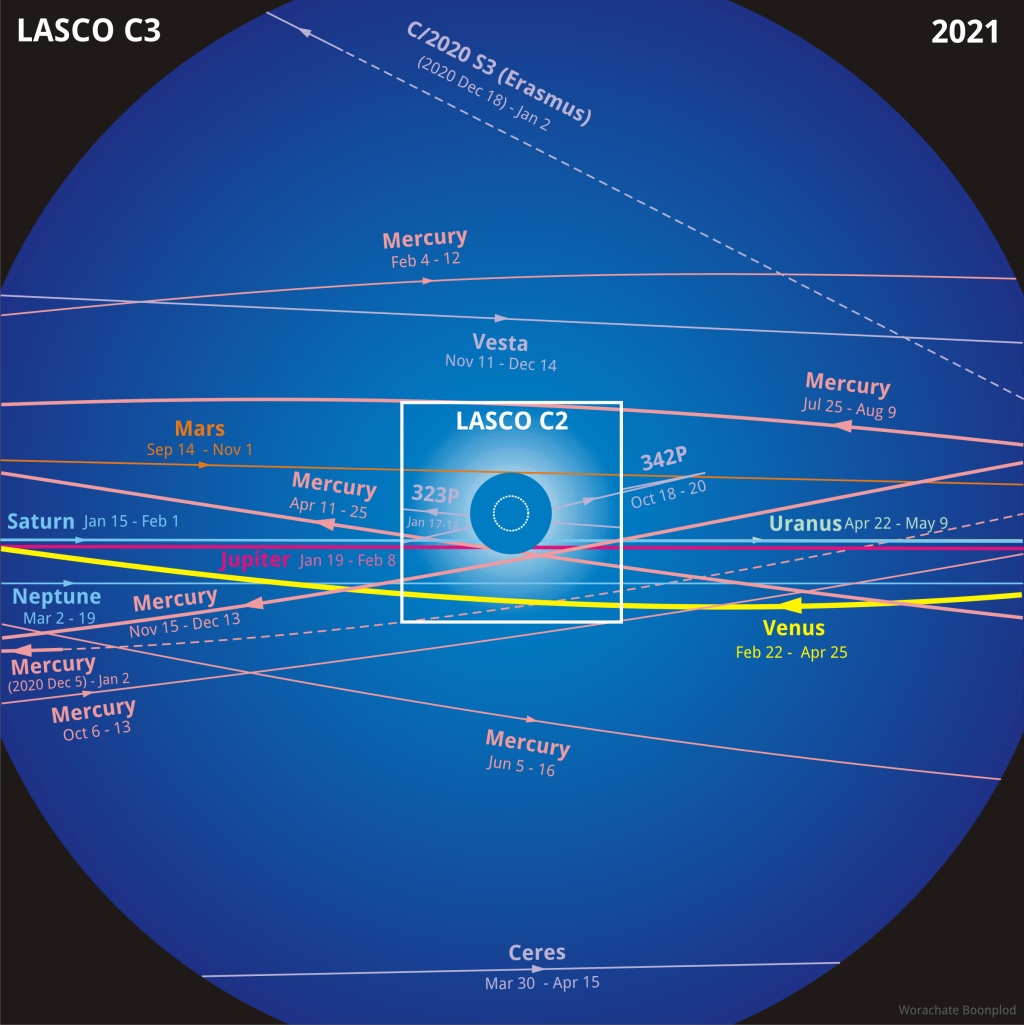
Worachate Boonplod
To anticipate what comes and goes under the coronagraphs' gaze, Thai amateur astronomer and SOHO comet hunter Worachate Boonplod created a 2021 coronagraph transit calendar and list of events (below). Each line in the image above represents the path of an object transiting either coronagraph's field of view. Arrows indicate the direction of motion. Objects labeled 323P, 342P, and C/2020 S3 are comets. The limiting magnitude for the LASCO C3 instrument is about 8.0 – 8.5 and 8.5 – 9.0 for LASCO C2.
| Visibility in LASCO C3 | Object | Magnitude | Direction |
| Jan. 19 – Feb. 8 | Jupiter | –1.9 | Left to right |
| February 4 – 12 | Mercury | +5 | Left to right |
| Feb. 22 – Apr. 25 | Venus | –4 | Right to left |
| March 2 – 19 | Neptune | +8.9 | Left to right |
| Mar. 30 – Apr. 15 | 1 Ceres | +9 | Left to right |
| April 11 – 25 | Mercury | –2 | Right to left |
| Apr. 22 – May 9 | Uranus | +5.9 | Left to right |
| June 5 – 16 | Mercury | +5 | Left to right |
| July 25 – Aug. 9 | Mercury | –2 | Right to left |
| Sept. 14 – Nov. 1 | Mars | +1.7 | Left to right |
| October 6 – 13 | Mercury | +5 | Left to right |
| October 18 – 20 | 342P/SOHO | +7 | Left to right to left |
| Nov. 11 – Dec. 14 | Vesta | +7.5 | Left to right |
| Nov. 15 – Dec. 13 | Mercury | –1 | Right to left |
Bookmark the SOHO images site, and when you're in the mood for some daytime observing or to see any of the events listed above, click on either the blue LASCO C3 or red LASCO C2 photo for the most current high-resolution image. To see archived photos, click on the orange More 512 × 512 links below the images. You can also watch an animation of each day's image-take at the LASCO coronagraph site.

ESA / NASA / SOHO / Karl Battams
A number of amateur astronomers routinely monitor SOHO images to find new comets in the Sun's vicinity that are otherwise invisible in daylight from the ground. More than 4,100 have been discovered to date including 600+ by Boonplod. Most of them are Kreutz sungrazers, fragments of a much larger comet that broke up centuries ago that continue to orbit the Sun.
To participate and potentially spot a new comet, check out The Official Guide to SOHO Comet Hunting or participate in The Sungrazer Project. If you regularly monitor the photos you'll also be among the first to catch sight of coronal mass ejections, massive outbursts of solar plasma launched into space that can spark spectacular auroras.
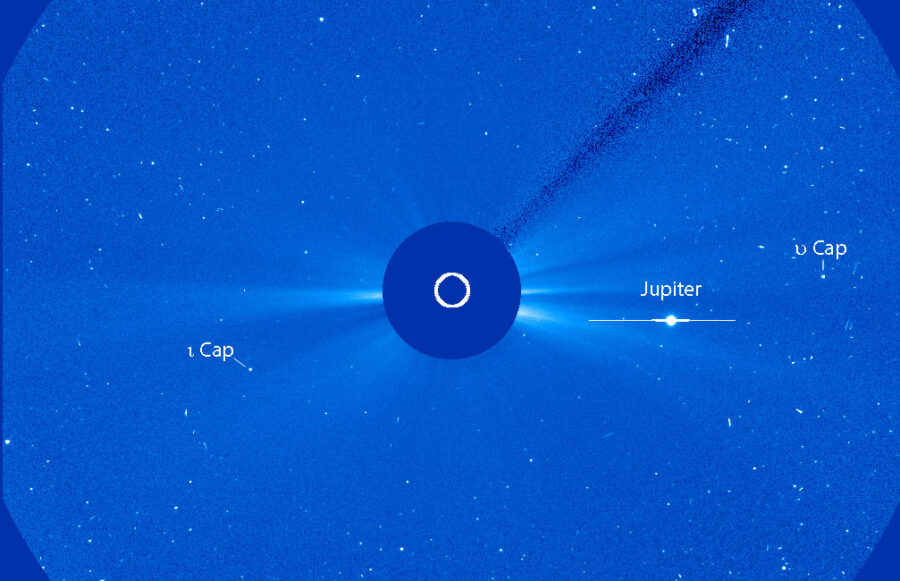
ESA / NASA / SOHO
 7
7









Comments
Anthony Barreiro
February 3, 2021 at 3:42 pm
It didn't make sense that outer planets would move through the field of view from left to right, i.e. east to west, when they're orbiting the Sun from west to east, so it seemed that they should be moving right to left. It took me a minute of waving my hands around while visualizing the orbits of an outer planet *and the Earth* to realize that the outer planet appears to move from left to right because the Earth is moving faster than the outer planet. Sort of the inverse of why the outer planets appear to move retrograde when they're at opposition. It also helped to remember that the outer planets are left of the Sun in evening twilight before conjunction, and right of the Sun during dawn after conjunction, at least as seen from Earth's northern hemisphere.
Such a complicated and interesting solar system!
SOHO is a venerable instrument. Twenty-five times around the Sun!
You must be logged in to post a comment.
Bob KingPost Author
February 4, 2021 at 10:22 am
Hi Anthony,
Good insight! What's different about the coronagraph is that it's tracking the sun, which makes the outer planets appear to move in exactly the opposite direction from normal.
You must be logged in to post a comment.
Anthony Barreiro
February 4, 2021 at 4:22 pm
So the Sun appears to move eastward relative to the background stars, and an outer planet is also moving eastward relative to the stars, but because the Earth is orbiting the Sun faster than the outer planet, the Sun appears to move faster than the outer planet, so the outer planet appears to move westward relative to the Sun. If I hold very still and squint, it makes sense! 😉
You must be logged in to post a comment.
Yaron Sheffer
February 6, 2021 at 1:15 pm
Guys, guys! Look, this is very simple. I am sure you both know that evening planets (left of the Sun for us northeners) always follow their acts as morning planets (to the right of the Sun). Always left to right. But we could never actually watch this transition next to the Sun before SOHO's LASCO.
My question is: where is the path for Uranus on the figure? Is it overlapping the path of Saturn? Are the two about to experience a conjunction?
You must be logged in to post a comment.
Anthony Barreiro
February 7, 2021 at 7:36 pm
Uranus is in the illustration and in the table. It will be in LASCO C3's field of view from April 22 to May 9, with solar conjunction on April 30. Uranus is currently about 80 degrees east of the Sun in ecliptic longitude (easily visible in binoculars about ten degrees west of Mars), and about 90 degrees east of Saturn. Saturn conjuncts Uranus about every 45 years. Their next conjunction will be in 2032.
You must be logged in to post a comment.
Yaron Sheffer
February 8, 2021 at 1:52 pm
Ha! Now it is I who made a mental blunder. Thanks for the clarification, Anthony. While the path of Uranus may be on top that of Saturn, I failed to take into account their temporal seperation! As shown, the two planets are about 3 months apart as the Sun "flies", and that means a difference of 1/4 year, or 90 degrees in longitude! WOW, this totally verifies your description...
You must be logged in to post a comment.
Yaron Sheffer
February 8, 2021 at 1:59 pm
P.S. Note that the label "Uranus" has a hue different than the path next to it. This path matches the color of "Saturn", though, so they must be overlapping. There's an arrowhead partly visible and matching the hue of "Uranus".
You must be logged in to post a comment.
You must be logged in to post a comment.